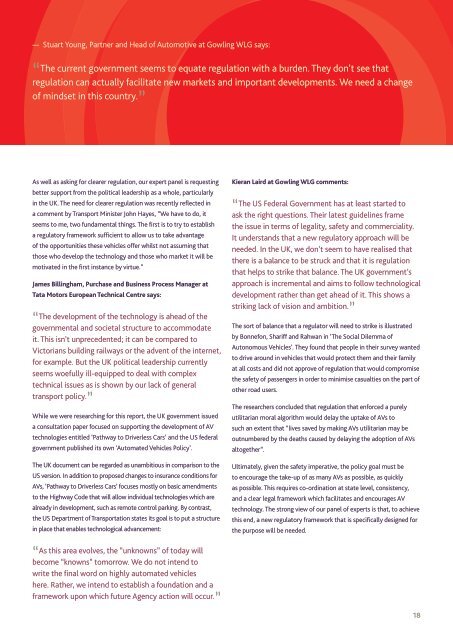THE MORAL ALGORITHM
161205-the_moral_algorithm
161205-the_moral_algorithm
Create successful ePaper yourself
Turn your PDF publications into a flip-book with our unique Google optimized e-Paper software.
——<br />
Stuart Young, Partner and Head of Automotive at Gowling WLG says:<br />
The Moral Algorithm \ Regulating morals<br />
“<br />
The current government seems to equate regulation with a burden. They don’t see that<br />
regulation can actually facilitate new markets and important developments. We need a change<br />
of mindset in this country.<br />
”<br />
As well as asking for clearer regulation, our expert panel is requesting<br />
better support from the political leadership as a whole, particularly<br />
in the UK. The need for clearer regulation was recently reflected in<br />
a comment by Transport Minister John Hayes, “We have to do, it<br />
seems to me, two fundamental things. The first is to try to establish<br />
a regulatory framework sufficient to allow us to take advantage<br />
of the opportunities these vehicles offer whilst not assuming that<br />
those who develop the technology and those who market it will be<br />
motivated in the first instance by virtue.”<br />
James Billingham, Purchase and Business Process Manager at<br />
Tata Motors European Technical Centre says:<br />
The development of the technology is ahead of the<br />
“<br />
governmental and societal structure to accommodate<br />
it. This isn’t unprecedented; it can be compared to<br />
Victorians building railways or the advent of the internet,<br />
for example. But the UK political leadership currently<br />
seems woefully ill-equipped to deal with complex<br />
technical issues as is shown by our lack of general<br />
transport policy.<br />
”<br />
While we were researching for this report, the UK government issued<br />
a consultation paper focused on supporting the development of AV<br />
technologies entitled ‘Pathway to Driverless Cars’ and the US federal<br />
government published its own ‘Automated Vehicles Policy’.<br />
The UK document can be regarded as unambitious in comparison to the<br />
US version. In addition to proposed changes to insurance conditions for<br />
AVs, ‘Pathway to Driverless Cars’ focuses mostly on basic amendments<br />
to the Highway Code that will allow individual technologies which are<br />
already in development, such as remote control parking. By contrast,<br />
the US Department of Transportation states its goal is to put a structure<br />
in place that enables technological advancement:<br />
Kieran Laird at Gowling WLG comments:<br />
The US Federal Government has at least started to<br />
“<br />
ask the right questions. Their latest guidelines frame<br />
the issue in terms of legality, safety and commerciality.<br />
It understands that a new regulatory approach will be<br />
needed. In the UK, we don’t seem to have realised that<br />
there is a balance to be struck and that it is regulation<br />
that helps to strike that balance. The UK government’s<br />
approach is incremental and aims to follow technological<br />
development rather than get ahead of it. This shows a<br />
striking lack of vision and ambition.<br />
”<br />
The sort of balance that a regulator will need to strike is illustrated<br />
by Bonnefon, Shariff and Rahwan in ‘The Social Dilemma of<br />
Autonomous Vehicles’. They found that people in their survey wanted<br />
to drive around in vehicles that would protect them and their family<br />
at all costs and did not approve of regulation that would compromise<br />
the safety of passengers in order to minimise casualties on the part of<br />
other road users.<br />
The researchers concluded that regulation that enforced a purely<br />
utilitarian moral algorithm would delay the uptake of AVs to<br />
such an extent that “lives saved by making AVs utilitarian may be<br />
outnumbered by the deaths caused by delaying the adoption of AVs<br />
altogether”.<br />
Ultimately, given the safety imperative, the policy goal must be<br />
to encourage the take-up of as many AVs as possible, as quickly<br />
as possible. This requires co-ordination at state level, consistency,<br />
and a clear legal framework which facilitates and encourages AV<br />
technology. The strong view of our panel of experts is that, to achieve<br />
this end, a new regulatory framework that is specifically designed for<br />
the purpose will be needed.<br />
As this area evolves, the “unknowns” of today will<br />
“<br />
become “knowns” tomorrow. We do not intend to<br />
write the final word on highly automated vehicles<br />
here. Rather, we intend to establish a foundation and a<br />
framework upon which future Agency action will occur.<br />
”<br />
18


